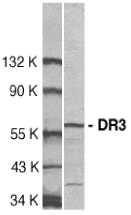Catalog# : 1120
Apoptosis, or programmed cell death, occurs during normal cellular differentiation and development of multicellular organisms. Apoptosis is induced by certain cytokines including TNF and Fas ligand of the TNF family through their death domain containing receptors, TNFR1 and Fas. A novel cell death receptor was recently identified by several groups independently and designated DR3, Wsl-1, Apo-3, TRAMP and LARD1-5. The ligand for this novel cell death receptor has not yet been defined. DR3 is highly expressed in the tissues enriched in lymphocytes including PBL, thymus and spleen. Like TNFR1, DR3 induces apoptosis and NF-kappaB activation.
Additional Names : DR3 (CT), Wsl-1, Apo-3
 Description
DescriptionLeft: Western blot analysis of DR3 in Jurkat total cell lysate with DR3 antibody at 1:500 dilution.
Source : DR3 antibody was raised against a peptide corresponding to amino acids 398 to 417 of human DR3.
Purification : Antibody is DEAE purified
Clonality and Clone : This is a polyclonal antibody.
Host : DR3 antibody was raised in rabbit. Please use anti-rabbit secondary antibodies.
Immunogen : Human DR3 (C-Terminus) Peptide (Cat. No. 1120P)
Application : DR3 antibody can be used for Western blot at 1:500 to 1:1000 dilution. A 59 kDa band should be detected and has no cross reaction to other death receptors.
Tested Application(s) : E, WB
Buffer : Antibody is supplied in PBS containing 0.02% sodium azide.
Blocking Peptide : Cat. No. 1120P - DR3 Peptide
Long-Term Storage : DR3 antibody can be stored at 4ºC, stable for one year. As with all antibodies care should be taken to avoid repeated freeze thaw cycles. Antibodies should not be exposed to prolonged high temperatures.
Positive Control
1.Cat. No. 1205 - Jurkat Cell Lysate
Species Reactivity :H, M, R
GI Number : 37181738
Accession Number : AAQ88676
Short Description : (CT) Cell Death Receptor
References
1.Chinnaiyan AM; O'Rourke K; Yu GL; Lyons RH; Garg M; Duan DR; Xing L; Gentz R; Ni J; Dixit VM. Science, 1996;274:990-
2.Kitson J; Raven T; Jiang YP; Goeddel DV; Giles KM; Pun KT; Grinham CJ; Brown R; Farrow SN. Nature, 1996;384:372-5.
3.Marsters SA; Sheridan JP; Donahue CJ; Pitti RM; Gray CL; Goddard AD; Bauer KD; Ashkenazi A. Curr Biol, 1996;6:1669-76.
4.Bodmer JL; Burns K; Schneider P; Hofmann K; Steiner V; Thome M; Bornand T; Hahne M; Schroter M; Becker K; et al. Immunity, 1997;6:79-88.

No comments:
Post a Comment